PURPOSE This study aimed to analyze factors associated with physical activity (PA) in older adults based on social ecological theory. METHODS Secondary analysis was conducted using raw data from the 2021 Community Health Survey. after excluding 129 non-responses in the PA domain, a total of 74,363 individuals were included in the final analysis. A total of eight factors, including personal (level of depression, history of falls), relational (relationships with neighbors, living alone), community (satisfaction with the local community system, safety), and environmental factors (living environment, natural environment), were selected in accordance with the key points of social ecological theory. To analyze social ecological factors related to the PA of older adults, we conducted a decision tree analysis using Chi-square automatic interaction detection (CHAID). RESULTS The average PA level among older adults was approximately 136 minutes, but the mode and median were both 0 minutes. A total of 20.2% of older adults met the physical activity recommendations, while 79.8% did not. According to the first split of the decision tree, living alone was the most relevant factor associated with the PA of older adults, followed by depression and falls. Older adults living alone, with a depression score of 10 or higher, and who had experienced a fall within the past year, were least likely to meet the PA recommendations. CONCLUSIONS This study urgently suggests that PA programs should target older adults living alone, experiencing depression, and falls.

Purpose The purpose of this study was to investigate changes of the cardiovascular system by comparing heart rate (HR) and blood responses to exercise in younger and older adult dogs and to verify the value of dogs as aging model in exercise science research. Methods A total of 11 healthy beagles were divided into 2 groups according to age: younger adult dogs (1~2 years old, 7 animals) and older adult dogs (9~11 years old, 4 animals). Each animal exercised on the treadmill for 25 minutes, twice a week, and for 4 weeks. The exercise intensity was gradually increased by applying four different protocols. Resting HR, HR during exercise, and HR recovery time were determined as HR parameters. Biochemical analysis was performed on blood samples. The independent Student’s t-test and one-way ANOVA were used to analyze the mean difference of each variable. The associations between age and HR parameters were determined using Spearman‘s analysis. Results Older adult dogs showed higher HRs during rest and exercise than younger adult dogs. HR recovery time was significantly longer in older adult dogs than in younger adult dogs. A strong positive relationship was observed between beagles’ age and resting HR, HR during exercise, and HR recovery time, respectively. The heart rate response to the treadmill exercise was similar between the 1st week and 4th week in younger and older adult dogs. Exercise significantly reduced the white blood cell level in older adult dogs and increased the alkali phosphatase level in younger adult dogs. Conclusions The results of this study demonstrated that short-term treadmill exercise may have a positive effect on the aerobic capacity, inflammation, and bone formation, suggesting that dogs are valuable as aging model in exercise science research.

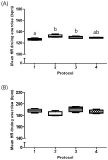
PURPOSE This study investigated the impact of underweight and hand grip strength (HGS) levels on the risk of all-cause mortality in older adults. METHODS Data from the 2006 baseline and 2020 follow-up assessments of the Korean Longitudinal Study of Aging (KLoSA), involving 3,009 older Koreans (≥65 years) were used in the study. Participants were categorized based on body mass index (BMI) as underweight, normal, overweight, or obese and grouped according to the Asian Working Group Sarcopenia criteria into high or low HGS. Cox proportional hazard models were used to estimate the hazard ratio (HR) and 95% confidence interval (CI) of all-cause mortality according to BMI and HGS categories. RESULTS During the 11.3±4.0 years follow-up period, 1,334 deaths from all causes occurred. The risk of death by BMI and HGS level was analyzed. The results showed that the risk of death in the overweight and high HGS group (HR=0.773, p=.016) was significantly lower than that in the normal weight & high HGS group (HR=1). In comparison, the risk of death in the underweight & low HGS group (HR=1.930, p<.001) and the normal weight & high HGS group (HR=1.225, p=.014) were significantly higher than normal weight & high HGS. However, the risk of death in the underweight and high HGS group showed no significant difference compared to the normal weight and high HGS group. CONCLUSIONS The current findings suggest that improving muscle strength through regular exercise may be important in preventing the risk of all-cause mortality due to being underweight.
[Purpose] This study evaluated the predictive power of Body Mass Index (BMI) for metabolic syndrome in older adults across pre-, during-, and post-COVID-19 periods, and examined the effects of metabolic syndrome factors on BMI by income level, aiming to inform elderly health management and crisis-related policies. [Methods] Data from 6,242 older adults (aged 65–80) were drawn from the 2019–2022 Korea National Health and Nutrition Examination Survey. Income was divided into quartiles, and time was segmented into pre-, during-, and post-pandemic periods. Multiple linear regression was used to assess the effects of metabolic syndrome factors (diabetes, abdominal obesity, low HDL, hypertension, hypertriglyceridemia) on BMI by income and period. Receiver Operating Characteristic (ROC) analysis evaluated BMI’s predictive power for metabolic syndrome. Significance was set at .05. [Results] Abdominal obesity and low HDL consistently influenced BMI across all groups. In the lowest income group, hypertension increasingly affected BMI during and after the pandemic. BMI Area Under the Curve (AUC) values peaked during the pandemic in this group, while the highest income group showed stable predictive power. [Conclusion] The COVID-19 pandemic had a differential impact on the association between BMI and metabolic syndrome among older adults according to income level. In low-income older adults, the predictive power of BMI for metabolic syndrome increased during the mid-pandemic period, while it remained stable across all periods in high-income groups. Systematic health management programs and policy interventions targeting low-income older adults are required to reduce health disparities during public health crises.
PURPOSE This study aimed to investigate the effects of accelerated rehabilitation exercise on physical fitness, lower extremity isometric strength, and blood variables in older adult women diagnosed with degenerative osteoarthritis. METHODS A total of 29 older adult women diagnosed with degenerative osteoarthritis residing in G city participated in the study, and 19 participants, excluding dropouts, took part in the experiment. They underwent exercise twice a week for 60 minutes per session over a period of 12 weeks. Pre- and post-experiment, the older adult fitness assessment (SFT), lower extremity isometric strength, and blood variables were measured. Data analysis was performed using SPSS 25.0, and paired sample t-tests were conducted to examine the effects before and after exercise. RESULTS The study results showed significant differences in body mass index (BMI) before and after exercise (p<0.05), and the older adult fitness assessment (SFT) showed significant differences in all items (p<0.01). Lower extremity isometric strength showed significant differences in absolute (Nm) and relative (%BW) values of 20° right flexion muscle (p<0.01). In terms of blood variables, significant differences were observed in creatine and ESR before and after exercise (p<0.01). CONCLUSIONS This study’s results suggest that regular physical activity and rehabilitation exercise programs can positively impact the muscular strength, cardiovascular endurance, exercise function, and blood composition of older adult women diagnosed with degenerative osteoarthritis. It is indicated that conducting future research, including periodic exercise programs, could be beneficial in promoting sustained exercise participation.
PURPOSE This study aimed to verify the criterion validity of the two-minute step test in older Korean adults, develop an equation for predicting VO2max, and verify cross-validation. METHODS A submaximal exercise test and the two-minute walk test were performed on 150 older adults (74 males and 74 females) aged 65 years or older. Correlation analysis was performed to confirm criterion validity. An equation for estimating VO2max was developed through multiple regression analysis, and cross-validation was confirmed by performing a correlation analysis between measured and predicted values of VO2max. RESULTS The correlation coefficient between VO2max and the two-minute step test was 0.457 (p<.001). The adjusted R2 of the developed VO2max prediction equation was 0.430 (p<.001), and the explanatory variables finally selected were sex, age, number of steps in the two-minute step test, and percentage of body fat. The correlation coefficient between the measured VO2max (19.08±4.36) and the predicted VO2max (19.73±3.36) was 0.654 (p<.001). CONCLUSIONS This study confirmed the criterion validity of the two-minute step test in older Korean adults, and the cross-validation of the developed VO2max prediction formula was verified. The explanatory variables of the prediction equation will be easy to apply in the field, and more meaningful results will be derived if the validity of the prediction equation developed for a larger number of participants is verified.
The frailty, characterized by reduced physiological function is closely related to a fall, disability, institutionalization, hospitalization, and mortality in the elderly. A reduced physical fitness is a major phenotype of the frailty. The purpose of this study was to investigate the relationship among pre-frailty, physical activity (PA) and functional fitness in the community dwelling elderly women. The study participants were elderly women (n=338, 70.6±4.2years) aged over 65 who took part in the Korean Healthy Fitness Criteria study for the National Fitness Award Project in 2015. The pre-frailty was defined using the Cardiovascular Health Study frailty criteria. PA was assessed using the International PA Questionnaire (IPAQ). The participants were classified as regular PA participants if they meet the World Health Organization (WHO) PA recommendation for the elderly. Functional fitness was assessed using the composite of the National Fitness Award fitness testing for the elderly. Quality of life was evaluated using EuroQoL visual analogue scale and WHO quality of life assessment. As the results, the pre-frail elderly women were significantly older and obese (body mass index, percent body fat, waist circumference) than the healthy elderly. The pre-frail elderly presented significant decreases in walking, moderate intensity, and total PA compared to the healthy elderly even after adjusted for age and percent body fat. However, no significant difference was found in vigorous-intensity activity between the pre-frail and healthy elderly. Also, the pre-frail elderly women showed the decrease in functional fitness and quality of life compared to the healthy elderly. Regular PA was associated with high levels of muscular endurance and coordination in healthy and pre-frail elderly. In pre-frail elderly, high levels of cardiorespiratory endurance was associated with PA. In conclusion, regular PA is inversely associated with fitness decline in healthy and pre-frail community-dwelling elderly women. Regular PA might attenuate fitness decline in pre-frail elderly women.

Purpose The present study was to investigate to extent that effects of sensory information distortion by muscle vibration on continuous limb movement in aging and accuracy constraint. Methods Young adult group (n=11) and older adult group (n=11) were divided. All participant were instructed to perform repetitive aiming movement to specified targets under three-accuracy constraints (i.e., low, high, and mixed accuracy constraints) in the vibration and no-vibration conditions. Kinematic data was collected by movement time and movement error frequence. Results The results showed that compared with young adult, older adult increased movement time when accuracy constraint was high under vibration condition. Older adult also was a high degree of movement errors than young adults when accuracy constraint was high under vibration condition. Conclusion The muscle vibration stimulation may influence considerably on the continuous limb movement probably due to degeneration in sensory information processing by aging.

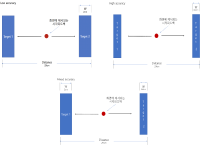
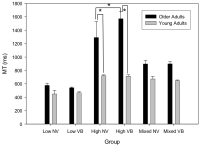
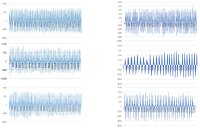
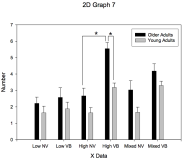
PURPOSE The purpose of this study was to examine the effects of an eye movement exercise intervention on cognitive function and prefrontal cortex connectivity in the elderly with mild cognitive impairment. METHODS Ten older adults with mild cognitive impairment participated in eye movement exercise consisting of saccadic eye movement, pursuit eye movement, vestibular-ocular eye movement, and vergence eye movement for 4 weeks. Cognitive function (MoCA-K), reaction time during stroop task, and prefrontal cortex connectivity were measured using the functional near-infrared spectrometric analyzer (fNIRS) before and after the intervention. RESULTS First, cognitive function of the elderly with mild cognitive impairment showed significant improvement after the eye movement exercise (p < .05). Second, reaction time decreased significantly from 1.16 to 0.91 ms after eye movement exercise. Third, the strength of prefrontal cortex connectivity (left OFC - right FPC, right OFC - right FPC) increased after the intervention in the older adults with mild cognitive impairment. CONCLUSIONS The results of this study suggest that eye movement exercise is an effective intervention for improving cognitive function through improvement of brain functional connection in the elderly patients with mild cognitive impairment.
Frailty in older adults is related to an increased risk for poor health outcomes including falls, disability, hospitalization and mortality. The purpose of this study was to determine the thresholds of a functional fitness associated with frailty for community-dwelling woman aged 65 or older. In this study, the National Fitness Award(NFA) items for elderly were utilized as the physical function and fitness testing for korean elderly women. The total of 444 community-dwelling woman completed the testings. Frailty status was classified by the Japan LTCI system ‘Kihon Checklist’ in the study. The prevalence of the frailty was 19.1% in the study. The frail elderly were older and showed higher obesity index such as weight, body mass index (BMI), percent body fat and waist circumference than the normal elderly. After adjusting for age and BMI which was related to frailty, fitness testing items were compared depending on frailty. As the result, the frail elderly showed significantly lower fitness levels in grip strength, 30-second chair stand test, timed up and go, figure-of-8 walk around two cones, and 2-minute step test than the normal elderly. When the fitness cut-off values were analyzed using the ROC curve, also, grip strength: 34.13%, 30-second chair stand test: 14 reps, timed up and go: 7.09 seconds, figure-of-8 walk around two cones: 30.88 seconds, and 2-minute step test: 93 reps. In addition, based on the cut-off values of each fitness item, the group with a low fitness level showed a 1.86 to 3.09 higher odds ratio of frailty than the group with a high fitness level, even after age and BMI were adjusted. In conclusion, these findings indicate that the fitness cut-off values in this study are fitness levels for preventing frailty of Korean elderly women and there will be a need for a large-scale study including subdivided fitness cut-off values for each age group and targets elderly men as well.